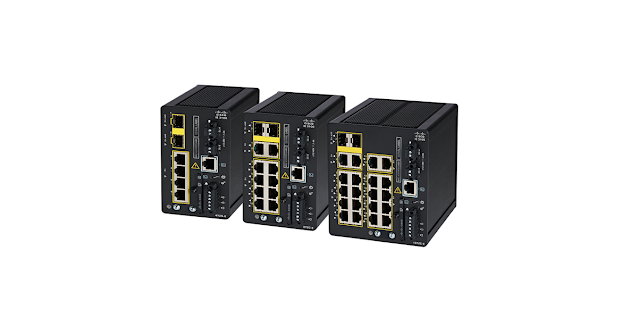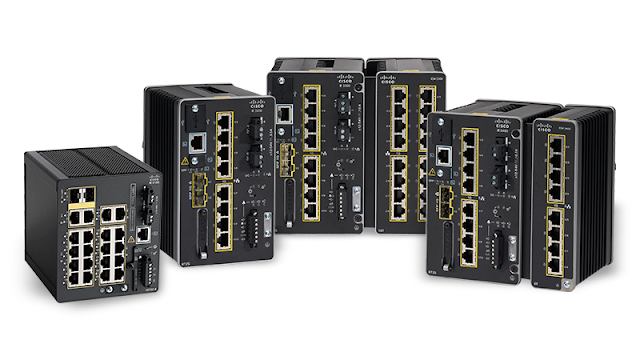Thursday, 6 April 2023
Cisco Catalyst IE3100 Rugged Series switches: Big benefits, small footprint
Tuesday, 4 April 2023
Scaling the Internet for the Future With 800G Innovations
Network Implications
New Cisco 800G Innovations
Operational Simplicity
Use Cases
Saturday, 1 April 2023
Good Friends Say Goodbye as Prime Infrastructure Sunsets
Cisco DNA Center
Migration Options
Migration Tools
Migration Services
Thursday, 30 March 2023
Failing Forward – What We Learned at Cisco from a “Failed” Digital Orchestration Pilot
Our Digital Orchestration Goals
Use Case #1: Seamlessly connect prescriptive actions across channels to our sellers, partners, and customers.
Use Case #2: Pause and resume a digital email journey based on triggers from other channels.
Use Case #3: Connect analytics across the multichannel customer journey.
Use Case #4: Easily integrate data science to branch and personalize the customer journey.
Finding Success
Tuesday, 28 March 2023
Cisco Modeling Labs 2.5: Now with Resource Limiting
What is resource limiting in CML 2.5?
How to configure CML resource limits
Create and assign resource pools
Create and define your template(s)
Limit access to external connectors
How to check resource usage
Highlights and benefits of CML 2.5 resource limits
Monday, 27 March 2023
Everything You Need to Know About Cisco 300-215: The Exam and Certification Guide
Are you planning to take the Cisco 300-215 exam to enhance your career prospects as a security engineer? If yes, then this article is for you. This article will cover all the essential information you need to know about the Cisco 300-215 exam, including the exam syllabus, preparation tips, and the certification process.
Know About Cisco 300-215 CBRFIR Exam
Cisco 300-215 CBRFIR exam, also known as Conducting Forensic Analysis and Incident Response Using Cisco Technologies for CyberOps, is designed to test the knowledge and skills of security engineers in conducting forensic analysis and incident response using Cisco technologies. The exam duration is 90 minutes and consists of 55-65 questions.
300-215 CBRFIR Exam Syllabus
The Cisco 300-215 CBRFIR exam syllabus is divided into six domains, each covering different topics related to forensic analysis and incident response. The domains are:
Fundamentals- 20%
Forensics Technique- 20%
Incident Response Techniques- 30%
Forensics Processes- 15%
Incident Response Processes- 15%
Target Audience
The target audience for the Cisco 300-215 certification exam is security engineers who want to specialize in conducting forensic analysis and incident response using Cisco technologies. This certification is ideal for professionals protecting and securing organizational assets, including networks, endpoints, and data.
The certification is also suitable for professionals who want to enhance their knowledge and skills in forensic analysis and incident response, regardless of their current job title or industry. It can benefit professionals in various fields, including:
- Cybersecurity: Cybersecurity professionals who want to specialize in conducting forensic analysis and incident response using Cisco technologies can benefit from earning the Cisco 300-215 certification. It demonstrates their expertise and enhances their credibility in the field.
- IT Operations: IT operations professionals responsible for managing and securing IT infrastructure can benefit from earning the Cisco 300-215 certification. It gives them the necessary knowledge and skills to effectively detect and respond to security incidents.
- Law Enforcement: Law enforcement professionals who are involved in investigating cybercrime can benefit from earning the Cisco 300-215 certification. It gives them the necessary knowledge and skills to conduct forensic analysis and incident response using Cisco technologies.
- Compliance: Compliance professionals are responsible for ensuring that organizations that comply with regulatory requirements can benefit from earning the Cisco 300-215 certification. It provides them with the necessary knowledge and skills to conduct forensic analysis and incident response to meet regulatory requirements.
300-215 Certification Process
Top 5 Cisco 300-215 CBRFIR Preparation Tips
1. Study the Exam Syllabus:
The exam syllabus is your roadmap to success. Make sure to study each domain thoroughly and understand the topics covered.
2. Use Study Materials:
Cisco provides official study materials, including books, videos, and practice tests, to help you prepare for the exam. You can also use third-party study materials from reputable sources.
3. Practice, Practice, Practice:
Practice is essential to passing the exam. Use practice tests to assess your knowledge and identify areas of improvement.
4. Join Study Groups:
Studying groups can help you learn from other candidates and share your knowledge and experiences.
5. Latest 300-215 Questions:
300-215 exam questions are confidential and not publicly available. Candidates should study the exam objectives and topics thoroughly and keep up with the latest trends and technologies in forensic analysis and incident response to prepare effectively for the exam.
Cisco 300-215 CBRFIR Benefits
- Career Advancement: Cisco 300-215 certification is recognized by industry leaders and can help you advance your career in cybersecurity and related fields. It demonstrates your knowledge and skills in conducting forensic analysis and incident response using Cisco technologies, making you a valuable asset to any organization.
- Competitive Edge: The cybersecurity industry is highly competitive, and earning Cisco 300-215 certification can give you a competitive edge over other candidates. It shows you have the necessary knowledge and skills to perform the job at a high level.
- Enhanced Skills and Knowledge: Preparing for the Cisco 300-215 exam requires a comprehensive study plan and a structured approach. Studying for the exam will enhance your skills and knowledge in conducting forensic analysis and incident response using Cisco technologies.
- Increased Earning Potential: According to PayScale, the average salary for a security engineer with Cisco Certified CyberOps Professional certification is around $106k annually. Earning this certification can increase your earning potential and lead to higher-paying job opportunities.
- Professional Development: Cisco 300-215 certification is valuable to your professional portfolio and can help you stand out in the job market. It demonstrates your commitment to professional development and lifelong learning.
Cisco 300-215 Scope
The Cisco 300-215 CBRFIR exam covers various topics related to conducting forensic analysis and incident response using Cisco technologies. The exam syllabus is divided into six domains, each covering different areas of expertise. Here is an overview of the scope of the Cisco 300-215 exam:
- Fundamentals of Forensic Analysis and Incident Response: This domain covers the basic concepts and principles of forensic analysis and incident response. It includes forensic investigation, evidence collection, and legal considerations.
- Network Forensics and Traffic Analysis: This domain covers network-based forensic analysis and incident response. It includes network traffic analysis, protocol analysis, and intrusion detection and prevention.
- Endpoint Forensics and Analysis: This domain covers endpoint-based forensic analysis and incident response. It includes malware analysis, memory forensics, and disk forensics.
- Incident Response: This domain covers incident response procedures and methodologies. It includes incident detection and analysis, classification and prioritization, and incident response planning.
- Incident Handling: This domain covers the practical aspects of incident handling. It includes containment, eradication, recovery, and communication and coordination with stakeholders.
- Incident Response Teams: This domain covers the organization and management of incident response teams. It includes team roles and responsibilities, incident response plan development and maintenance, and incident response team training and exercises.
The Cisco 300-215 exam covers various topics related to forensic analysis and incident response using Cisco technologies. The domains cover the field's theoretical and practical aspects, making it a comprehensive certification for security engineers.
Conclusion
The Cisco 300-215 CBRFIR exam is an essential certification for security engineers who want to specialize in conducting forensic analysis and incident response using Cisco technologies. Following the tips and guidelines in this article, you can prepare for the exam and pass it with flying colors.
Good luck!
























